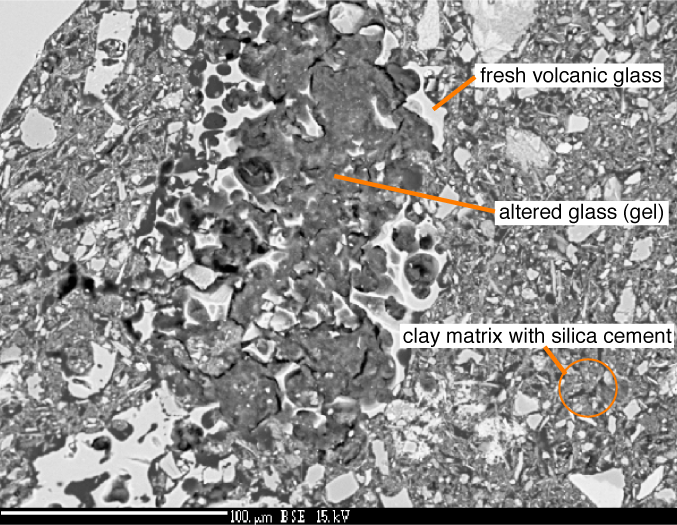Reports: G8
46682-G8 Sediment Stabilization and Anomalous Porosities Resulting from Minor Opal Cementation
Cementation affects mechanical properties that control sediment strength and deformation. A small volume of grain coating cement can increase sediment strength and inhibit consolidation. Burial of cemented sediment can generate anomalous porosities. I am examining silica cementation and the generation of anomalous porosity in potential reservoir seal rocks, and the controls on its spatial distribution.
A small amount of grain-coating silica cement affects sediment properties and deformation at Ocean Drilling Program (ODP) sites 1173 and 1177 offshore Japan. The cemented sediment has anomalous porosity, seismic velocity, and rigidity. With burial and increasing temperature, failure of the cement leads to collapse of the sediment framework and dramatic porosity loss. Previous studies suggest that a minor amount of opal-CT cement inhibits consolidation of the sediment at sites 1173 and 1177. I am examining additional sites offshore Japan (Deep Sea Drilling Project sites 297, 442, 443, 444, 582) to determine if similar cementation of hemipelagic sediment is common and what effects this cement has on sediment strength and deformation.
Figure 1: Backscattered electron image of sediment from the upper Shikoku Basin facies offshore southern Japan. A volcanic glass shard, typical of many in the sediment, shows small remnants of fresh glass and a gel produced by alteration of the glass. The altered material is disseminated in the surrounding pore space, potentially affecting sediment strength and deformation.

Sediment samples for these sites were collected from archived sediment cores the Integrated Ocean Drilling Program core repositories. The amorphous silica content of sediment samples from the sites is determined using an alkaline leaching method. The nature and distribution of the cementing material is detected through secondary and backscattered electron (SEM and BSE) images. Sediments throughout Shikoku Basin are affected by silica cementation. The amorphous silica content of the upper Shikoku Basin facies is higher (~1 wt% of the sediment) than in the lower Shikoku Basin facies (<0.25 wt%). The position of the upper/lower Shikoku Basin facies boundary appears to be controlled by silica diagenesis. In the upper Shikoku Basin facies, amorphous silica is visible as a coating at grain contacts, filling voids in zones of clastic material, and as altered material in contact with volcanic glass shards. The observed amorphous silica appears to be sourced from these volcanic glass shards. Electron microprobe analyses indicate that the amorphous silica is nearly identical in composition to adjacent volcanic glass shards, but with much higher porosity. Mass balance calculations indicate the amorphous silica phase is mobile; it is disseminated throughout the surrounding pore space and may be the material strengthening the sediment.
This grant supported a Native American graduate student (M.S.) at New Mexico Tech, Mr. Russell White. In summer 2009, he received his Master's degree; he is taking a position as a geoscientist with Anadarko. Based on Mr. White's research, we are in the process of publishing two articles in peer-reviewed journals.




